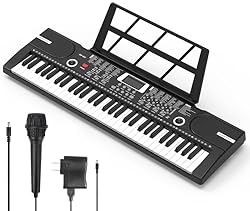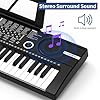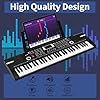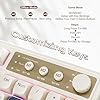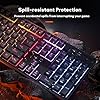Table of Contents
Introduction to Piano Pedaling Techniques
The art of piano pedaling is an essential skill for pianists, adding depth and richness to the music. Pedaling involves using one’s feet to press the pedals at the base of the piano, which radically alters the instrument’s sound. There are several types of pedals, but the three most common are the sustain pedal, the soft pedal, and the sostenuto pedal. Mastering the use of these pedals enhances musical expression and contributes to a more nuanced performance. This introduction explores the basic techniques and subtleties involved in effective piano pedaling, setting the stage for more advanced discussions on the topic.
Introduction to the Sustain Pedal and Its Uses
At the heart of expressive piano performance lies the adept use of pedaling techniques, with the sustain pedal being the most widely utilized among them. Officially known as the damper pedal, it plays a crucial role in enhancing the harmonic richness and resonance of piano music. When the sustain pedal is engaged, the dampers are lifted off the strings, allowing them to vibrate freely. This effect not only sustains the notes being played but also enables the blending of successive notes to create a seamless, lyrical passage.
Piano Adventures: Technique and Artistry Book - Level 1, 2nd Edition | Beginner Piano Method for Expressive Playing | Sheet Music Songbook for Finger Technique | Faber Piano Music Book
11% OffPiano Adventures: Technique and Artistry Book - Level 3A, 2nd Edition | Sheet Music for Developing Pianists | Piano Technique Book with Artistic Performance Focus | Faber Piano Method Book
11% OffScales and Finger Exercises for Piano | Classical Technique Sheet Music Book for Beginners and Intermediate Players | Major and Minor Scales and ... Library of Musical Classics, 2107)
$9.99 (as of November 22, 2025 23:38 GMT -08:00 - More infoProduct prices and availability are accurate as of the date/time indicated and are subject to change. Any price and availability information displayed on [relevant Amazon Site(s), as applicable] at the time of purchase will apply to the purchase of this product.)Scales and Chords for Piano | Schirmer Library of Classics Vol 392 | Piano Technique Book in All Major and Minor Keys | Classical Sheet Music for Beginners and Intermediate Players
$6.99 (as of November 22, 2025 23:38 GMT -08:00 - More infoProduct prices and availability are accurate as of the date/time indicated and are subject to change. Any price and availability information displayed on [relevant Amazon Site(s), as applicable] at the time of purchase will apply to the purchase of this product.)The magic of the sustain pedal extends beyond merely prolonging the sound; it enriches the piano’s tone and facilitates complex musical expressions that would be impossible otherwise. Mastery over this pedal is essential for achieving the full emotional and dynamic range the piano has to offer. As such, understanding and implementing the appropriate pedaling techniques is fundamental for both aspiring and seasoned pianists aiming to refine their musical articulation and interpretative skills.
How to Coordinate Pedaling with Playing
Coordinating pedaling with piano playing requires precise timing and an understanding of the musical texture. Here’s a detailed look into the process:
Listen Carefully to the Sound
First and foremost, listen to the sound produced while you play. The pedal should enhance the music, not muddy it. Practice in a quiet environment to clearly hear the effect of the pedal.
Practice Pedaling Techniques
Understand different pedaling techniques such as legato pedaling, syncopated pedaling, and partial pedaling. Each technique serves a different musical purpose and should be practiced with conscious attention to how they affect the sound.
Yamaha Arius Series 88-Key Weighted Action Upright Digital Piano, CFX Concert Grand Piano Voice, 3-Pedal Unit, Bench Included, Classic Upright Design, Black YDP145B
17% OffFree Piano - Learn to Play Piano
$0.00 (as of November 22, 2025 22:56 GMT -08:00 - More infoProduct prices and availability are accurate as of the date/time indicated and are subject to change. Any price and availability information displayed on [relevant Amazon Site(s), as applicable] at the time of purchase will apply to the purchase of this product.)Classical Piano for Sleep and Relaxation
$9.99 (as of November 22, 2025 22:56 GMT -08:00 - More infoProduct prices and availability are accurate as of the date/time indicated and are subject to change. Any price and availability information displayed on [relevant Amazon Site(s), as applicable] at the time of purchase will apply to the purchase of this product.)61 keys keyboard piano, Electronic Digital Piano with Built-In Speaker Microphone, Sheet Stand and Power Supply, Portable piano Keyboard Gift Teaching for Beginners
$164.00 (as of November 22, 2025 23:10 GMT -08:00 - More infoProduct prices and availability are accurate as of the date/time indicated and are subject to change. Any price and availability information displayed on [relevant Amazon Site(s), as applicable] at the time of purchase will apply to the purchase of this product.)Coordinate Pedal with Hand Movements
Begin by slowly pressing the pedal as you play a note or chord. This coordination is critical, as it ensures that the release and depression of the pedal match the timing of the notes being played. Generally, the pedal should be pressed just after a note is played and lifted as you change chords or notes, depending on the desired effect.
Use Pedal Marks as a Guide
Sheet music often includes pedal markings, which provide guidance on when to press and release the pedal. Treat these markings as suggestions and adapt them based on the acoustics of the room and the tone of the piano.
Experiment with Different Pedal Depths
The depth to which the pedal is depressed can vary the sound’s sustain and clarity. Experiment with different depths to find the right balance that complements the music piece.
Record and Review Your Performance
Recording your playing can provide insights into how effectively you are using the pedal. Listen critically to identify areas that might need adjustment, such as timing or pedal depth.
Practice Regularly
Effective pedaling is achieved through consistent practice. Integrate pedaling into your daily practice sessions to develop a more intuitive feel for its application within various musical pieces.
Advanced Pedaling Techniques for Expressiveness
The use of the damper pedal, sostenuto pedal, and una corda pedal on the piano can greatly enhance musical expressiveness. Understanding and mastering various advanced pedaling techniques allows pianists to produce a wide range of tonal colors and atmospheric effects in their playing.
Half-Pedaling
Half-pedaling involves partially depressing the damper pedal. This technique allows for a subtler release of the dampers, enabling the strings to resonate less fully than with full pedaling. Half-pedaling is particularly useful in pieces where a full sustain would overwhelm the texture but some degree of blending and sustain is still desirable.
Flutter Pedaling
Flutter pedaling entails quickly and repeatedly depressing and releasing the damper pedal. This technique is used to create a shimmering, fluctuating sound effect, which is useful for sustaining tone while clearing muddiness in rapid passages.
Selective Sostenuto
The sostenuto pedal, often the middle pedal on modern grand pianos, allows selective sustain of certain notes. Pressing the sostenuto pedal after playing specific notes, and then releasing the damper pedal, keeps the selected notes sustained while allowing others to be played staccato. Selective sostenuto can achieve a layered sound effect, adding depth and complexity to the musical texture.
Fractional Pedaling
Fractional pedaling is an advanced technique that involves varying degrees of pedal depression. This can range from quarter to three-quarter pedal, depending on the amount of sustain and tonal blending required. It’s highly effective in controlling the acoustic clarity and blending the lines without creating excessive resonance.
Delayed Pedaling
In delayed pedaling, the pedal is pressed down after the note or chord is played. This technique ensures that the initial attack is clear and that the resonance is added immediately after. Delayed pedaling is crucial for achieving clean articulation with a lingering sustain, adding richness to the sound without losing the initial clarity of the note or chord.
Rhythmic Pedaling
Rhythmic pedaling aligns the pedal changes with specific rhythmic patterns or the natural phrasing of the music, rather than strictly with hand movements. This approach requires acute auditory skills, as the pedaling must precisely match the rhythmic impulses of the piece to enhance the overall musical expression.
By mastering these advanced pedaling techniques, pianists can fully explore the expressive capabilities of the piano, offering a more dynamic and emotionally resonant performance.
Common Pedaling Mistakes and How to Avoid Them
Overpedaling: This occurs when the sustain pedal is held down too long, causing a muddy or blurred sound. To avoid overpedaling, listen carefully to the clarity of the notes. Release the pedal completely at the end of a phrase or before a change in harmony to maintain clear articulation.
Underpedaling: Underpedaling happens when the pedal is not used enough, leading to a choppy or detached sound. This can be prevented by carefully using the pedal to connect notes that cannot be connected by the fingers alone. Practicing with a slow, deliberate pedaling technique helps develop a better ear for when and how much to pedal.
Incorrect Timing: Delayed or early pedal changes can disrupt the musical flow. The pedal should generally be changed right after playing a new chord or note to catch the new harmony. To improve timing, practice pedaling in slow motion, focusing on coordinating the hands and foot to synchronize the pedal change with the playing of new notes.
Half-Pedaling and Flutter Pedaling Inconsistencies: Half-pedaling allows some strings to vibrate, creating a less sustained sound, while flutter pedaling involves light, rapid pedal changes. Both techniques require precise control and can vary between different pianos. To master these techniques, experiment with different levels of pedal depression in a consistent rhythmic pattern, paying close attention to the resulting sound.
Ignoring the Soft Pedal (Una Corda): The soft pedal changes the timbre of the piano by shifting the hammers so that they strike fewer strings. Neglecting this pedal can result in a lack of tonal variety in your playing. Practice passages using the una corda to familiarize yourself with its effect and incorporate it into passages that benefit from a softer and more subdued sound.
Excessive Use of the Sostenuto Pedal: The sostenuto pedal sustains selected notes, while allowing others to be played staccato. Overusing this pedal can lead to a cluttered sound. Use it selectively for passages where sustaining specific notes enhances the musical expression without blurring other parts.
Not Adapting to Different Pianos: Each piano responds differently to pedaling techniques, especially in terms of pedal sensitivity and decay rates. When playing a new piano, spend time exploring how it responds to different pedaling approaches, adjusting your pedaling to accommodate the instrument’s unique characteristics.
Exploring the Una Corda Pedal
The Una Corda pedal, often referred to as the soft pedal, is typically found on the leftmost side of the three pedals on a grand piano. Its main function is to modify the timbre and volume of the sound produced, rather than merely softening the notes. When this pedal is depressed, the entire keyboard mechanism, known as the action, shifts to the right. This shift results in the hammers striking fewer strings per note—typically two strings instead of three for most of the keys on a grand piano, and sometimes only one string (hence the name ‘una corda’).
This pedaling technique is especially useful in pieces that require a delicate and subtle sound expression. It allows the pianist to play with a softer, more muted tone, which can create an ethereal or intimate atmosphere in the music. Not only does it reduce the volume, but it also changes the quality of the sound, since the hammers strike parts of the string that are less frequently hit, producing a slightly different tone.
For upright pianos, the una corda pedal functions differently. Instead of shifting the action, it moves the hammers closer to the strings, which reduces the force of the blow and consequently the volume, but does not affect the number of strings struck by each hammer.
Exploring the Sostenuto Pedal
The Sostenuto pedal is typically the middle pedal found in many grand pianos and certain upright pianos. This pedal is unique in its operation and effect, as it sustains only selected notes. By pressing the keys you wish to sustain and then depressing the sostenuto pedal, those dampers are held up, allowing those specific notes to continue sounding even after releasing the keys.
This selective sustain allows for complex playing techniques where the pianist can sustain certain notes while other parts of the keyboard can be played staccato or with no sustain. This is particularly useful in modern classical and contemporary music compositions that require intricate layering effects and precise sound control. The sostenuto pedal offers creative possibilities that are not achievable with the other pedals.
Not all pianos, particularly older or budget models, come equipped with a functional sostenuto pedal. In some cases, the middle pedal might be a practice pedal that muffles the sound or serves another purpose.
Conclusion
Mastery of piano pedaling techniques is crucial for rendering the nuances and depth of musical pieces. Effective use of the sustain pedal, soft pedal, and sostenuto pedal can transform performances, enabling pianists to achieve a broader range of emotional expressions. Pedaling requires a delicate balance, reflecting both the composer’s intentions and the performer’s interpretation. By continual practice and listening attentively to the sound produced, pianists can enhance their pedaling skills to deliver more expressive and resonant performances.


































